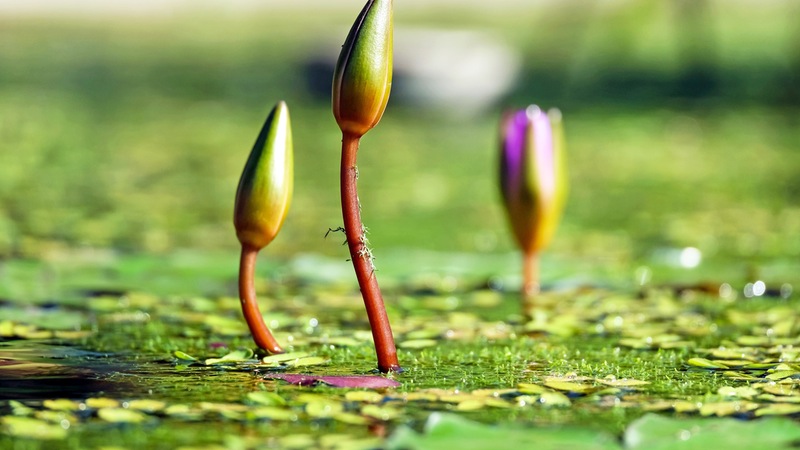Ponds are outdoors, and this means they are at the mercy of the elements. This can be bad news in the winter, when cold temperatures can freeze the water and potentially cause harm to wildlife. So, how to stop a garden pond freezing over?
Well, I’m glad you asked! We’ve put together some useful tips for you to keep your pond ice free.
How To Stop A Garden Pond Freezing Over?

There are a good few things you can do to prevent your pond from freezing over in the winter:
- Float something in it. Something that floats around on the surface and moves will prevent the ice forming all the way across.
- Cover the pond. Spreading a sheet over the whole pond will keep it slightly warmer and stop it from freezing over.
- Keep the water moving. Running a pump will keep the water moving and prevent the pond from freezing over.
- Try a pond heater. These nifty little gadgets will keep the water above freezing temperature.
This little article has some useful tips on keeping your pond ice free in winter.
Does A Tennis Ball Stop A Pond Freezing?
Placing a tennis ball into your pond may not make it look more attractive, but it can help the stop the pond from freezing over completely in winter.
The tennis ball will float in the water, and this will stop ice from being able to form all over the surface.
This method is just about the easiest that you can use to stop your pond from freezing right over, and it will barely cost you anything either!
Making sure the water does not stay frozen means that wildlife can still drink from the pond, which is great when many other water sources will be iced up.
Keeping hole in the ice will also allow vital oxygen to get to the water, and allow CO2 to escape too – this is vital to the health of wildlife in your pond.
How Do I Protect My Garden Pond In The Winter?
As the colder months approach, there are a great many things you can do to prepare your pond for the cold snap to ensure it stays as healthy as it can.
- Remove leaves, debris and algae. Keeping your pond as clean as it can be will help it going into the winter, and means that you have less to clean the following year.
- Trim back overhanging foliage. Stopping leaves and twigs from falling into the pond will help it when the temperatures drop to freezing.
- Consider adding a pump. If you don’t already have one, a pump or vacuum can be a useful gadget to stop the water from totally freezing over in the depths of winter.
- Cover the pond. To protect the water and the wildlife, covering the pond entirely with a sheet of plastic will stop it from getting too cold.
- Reduce fish feeding. If you have fish, they will become dormant in the winter and any extra food will just decompose over time.
- Throw in a tennis ball. If you don’t want to do too much to your pond, a simple tennis ball in the water will stop it from freezing over completely.
- If your pond is too shallow to protect your pond plants in the winter, you can remove them from the pond, place them in a cool box and keep them dark and damp. Remember to water them a couple of times a month!
Here is a useful video, explaining the best ways to keep your pond protected in the colder months:
Are Fish OK If Pond Freezes Over?
Although we might feel very sorry for them, fish can actually cope surprisingly well if their pond freezes over.
When it gets cold, fish and other water dwelling creatures tend to slow down and use up less oxygen.
Fish can survive in a frozen pond for a few days, but if it stays frozen over for a long time – we’re talking a week or more – then you will need to start breaking the ice.
Some fish, Koi carp in particular, can end up with health problems if they stay too cold for too long, so keeping an eye on the temperature of your pond is a good idea.
Making holes in the ice allows oxygen to reach the water, and also helps release the CO2 build up.
You will need to take care when breaking the ice; using a hammer to smash it (although fun!) is not recommended as it can stress the fish.
Instead, rest a hot pan on the surface for a few minutes until the ice melts. You can also pour hot water on the ice, but you will need to spot where the fish are first, and do not pour it directly over them.
How Deep Should A Pond Be To Avoid Freezing?
Although cold enough weather will freeze just about any water to just about any depth, as a general rule there is a depth that ice cannot penetrate.
If you want to avoid your entire pond freezing over, dig it to a depth of at least 4 feet. This is recommended for ponds with expensive fish, but don’t worry – your wildlife pond can be shallower!
18 inches is the shallowest you can go to prevent the risk of the entire pond freezing over completely.
However, as we know, weather can be unpredictable – if you want to be absolutely certain of keeping your wildlife pond safe, go for 30 inches or even deeper, if you have the space.
Final Words
Once you’ve figured out how to stop a garden pond freezing over you can make sure that your pond wildlife stays as safe as it can during the winter months!
Most wildlife is used to the winter conditions and so will survive even the coldest temperatures – but it’s best to stop them from freezing solid!






